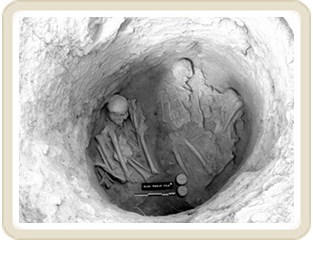Latest News
04/07/11
Excavations are now complete and the team is in the planning stages for studies and publication.
Souskiou-Laona Cemetery

The Souskiou-Laona cemetery is located on the East Ridge of a narrow spur between the Dhiarizos River and the Vathyrkakas stream, near the abandoned village of Souskiou. It occupies a commanding position on the ridge, with views west over the Dhiarizos Valley to the Ktima Lowlands and the Mediterranean, and east to the Troodos Mountains. It seems likely that visibility both to and from the cemetery was a factor in choice of location for the Chalcolithic peoples.
The Laona cemetery is on an outcrop that rises above the ridge to a height of 1-3 m and measures approximately 25 m east-west and 40 m north-south. Prior to excavation, approximately 25 tomb apertures, or depressions signalling a likelihood of looted tombs, were visible. We have now recorded a total of 137 tombs and a range of other features, completing investigation of the entire top of the outcrop.
Tombs at Laona are simpler than in the Vathyrkakas cemetery, but the same burial programme exists here. That consists of a collective tradition of inhumations at the base of often bottle-shaped pits cut into the bedrock and sealed with removable capstones slotted into prepared hollows around the top of the pits. The physical anthropological and contextual bioarchaeological analysis of the human skeletal remains has barely commenced, but already some interesting results are emerging. One of these is the patterning in burial position shown by the intact, articulated skeletons, and the distinct patterning in the secondary deposition of skeletal material, the bone stacks.
Grave goods recovered from within the tombs include Red-on-White pottery vessels, the most noteworthy an anthropomorphic vessel still to be conserved, picrolite pendants with dentalium shell beads, a large picrolite figurine, chipped stone tools, faience beads and copper objects. The faience and copper are amongst the earliest occurrences of these materials on Cyprus. Examples come from several tombs including Tomb 158.Like many others, Tomb 158 was cut into bedrock to a depth of 1.50m. It had an upper fill of capstone fragments, boulders and smaller angular stones and a lower one of yellowish brown sand, silt and larger stones, softer towards the centre of the tomb but compacted against the edges. The burials lay in a typical intact burial deposit of loose yellowish, sandy silts, although still concreted to the walls at the side and base. There was an articulated individual in the eastern end of the tomb, and there were two bone stack areas. The articulated individual lay in what seems to be the standard position for complete articulated skeletons on the site, that is arms and legs flexed, lying on its back, on the right side. Opposite were two bone stacks containing the remains of four adults and one sub-adult. Amongst the finds was a unique Red-on-White tripod flask, along with copper artefacts, faience beads, Dentalium shells and chipped stone. Grave goods were associated with both the articulated individual and the bone stacks.